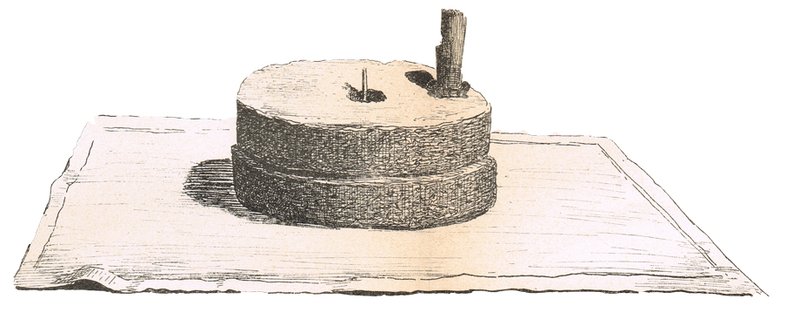Tahin?

Of course, you will note that this is a native Syrian recipe, simply judging from the Arabic word “tahin/tahini/tahineh ” which in fact simply means “milled/աղաց” at times it also means flour/ալիւր.
http://www.csf1.com/img_4743-qpr.jpg
http://en.wikipedia.org/wiki/Tahini
Tahini {also tehina) (Arabic: طحينه), is a paste of ground sesame seeds used in North African, Greek, Turkish and Middle Eastern cuisine. It is made of hulled seeds. East Asian tahini is made of unhulled seeds.
Tahini is a major component of hummus and halva.
The Arabic word “tahhan” means miller/ջաղացպան, at times used as a family surname, just like the Armenian ջաղացպանեան/chaghatspanian. {Deyirmenjian/ Dekirmenjian/Dekermenjian/Degirmenjian/Dermenjian….etc)
In fact the Armenian word ջաղաց/jaghats is an abbreviation of ջրաղաց/jraghats-water mill.
http://www.heqiat.am...y_shangynex.jpg
Stone mill

http://myschool.in.c...28160508805.jpg
http://www.yerkaran....zs-badig-badig/
http://www.heqiat.am...mid=708&lang=hy
Now that we know tahini is the pressed milled paste of sesame/sumsum, what would be the Armenian word for it?
Sesame bush
http://pics.davesgar...mbob/3ba3a7.jpg
Sesame seed
http://web.tradekore...n/o_P276679.jpg
Note the AramaicEtymology-1425; Middle English sisamie, from Middle French sisame, learned borrowing from Latin sīsamum, variant of sēsama, from Ancient Greek σησάμη (sēsámē) (obl. σήσαμον (sḗsamon)) ‘sesame seed’, from Old Aramaic šwšmʾ (šuššma), shortening of šwmšwmʾ (šumššema),
Old Aramaic šwšmʾ (šuššma), above to be read as “shushma“.
In the Armenian we know that seed as շուշմա/shushma”and կնճութ/knjouth”
AH!! See what the Persian call it “knjtا/کنجث ، those others call it”kunju/kunci”, thinking that in their non-language the T/D ending is the Arabic silent T.
Not to confuse with this ԿՆՃԻԹ elephant trunk, or pig snout.
http://www.gamepark..../133715_tmb.jpg
http://www.jameswarw...TRUNK@thumb.jpg
See աղալ to mill and աղօրիք** windmill here;
ԷՋ 1314 / 2705 and ԷՋ 1315 / 2705
http://www.nayiri.co...pageNumber=1314
[img]http://www.jameswarwick.co.uk/resources/listimg/gallery/Samburu_2009/032-ELEPHANT-TRUNK@thumb.jpg[/img ]
So, what would you call “tahini” in Armenian? Շուշմաղաց կն/ճիթաղաց?
I have heard some suggest that we call it “թաղան/taghan.
Why do I cry everytime I read Saint Varuzhan??
**ԱՂՕՐԻՔ by Daniel Varuzhan
ԱղՕրիք please, not ԱղՈրիք
Obviously Vartahoor did not edit the orthograpy from wherever he copied.
ԱՂՈՐԻՔ
Է՜յ աղորիք, դարձի՛ր, դարձիր,
Նըստած կանանչ խորը ձորին.
Աղաղակե՛ երգըդ խորին
Դեպի լուսնակն արծաթածիր:
Դուն դողդոջուն տընակ մըն ես
Ալյուրոտած պատերով` ուր
Կարծես կու լան հիազարհուր
Ջըրանույշներ հագած բեհեզ:
Միշտ կը հըսկե մեջըդ արթուն,
Աղորեպանը ճեփ-ճերմակ.
Եվ ըստ պետքի` մեղմ կամ արագ`
Կը լարե սի՛րտըդ բաբախուն:
Է՜յ աղորիք, բանտվա՛ծ մրրիկ
Ծառերուն մեջ. Աղա՛, աղա՛,
Փըրփուր խըմե՛, ալյուր տեղա՛.
Քարե կուրծքեդ տեղա՛ բարիք:
Կեցո՛ւր գետակն ընթացքին մեջ
Իր ծըփանուտ բաշեն բըռնած:
Ջըրվեժն ահեղ երգի փոխած
Պոռթկա վիհեն վար գահավեժ:
Սայլե՜ր, սայլե՜ր անծայրածիր
Ջաղացքներուն ճերմակ ճամբեն
Աղոնն իրենց քեզ կը բերեն…
Է՜յ աղորիք, դարձի՛ր, դարձիր:
Ցորեններ թող ալյուր ըլլան
Պորտին մեջ ժիր երկաններուն`
Որոնք բռնված տենդով մ’անհուն
Կը մըռըլտան ու հիռ կու գան:
Ցորեններ թող ըլլան փոշի
Զիրար գըրկող քարերուն տակ.
Զիրար կըրծող ժայռերուն տակ
Ցորեններ թող ըլլան նաշիհ:
Մինչև լեցվին շարան շարան
Պարկերն, ու վե՛ր կանգնին նորեն.
Եվ սայլերն ալ ճըռվողելեն
Ոսկի թողած լույսով դառնան:
Edited by Arpa, 28 April 2012 - 09:59 AM.














